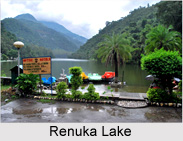 Renuka Lake situated in the Sirmaur district of Himachal Pradesh is the largest natural lake in the state. The lake is situated at an altitude of 672 m above mean sea level and has a circumference of 3214 m. The lake is situated at a distance of 123 km from Parwanoo, 60 km from Paonta Sahib and 37 km from Nahan. This placid stretch of water is fed by underground springs and the surrounding hills are padded by lush forests that support a large variety of plant and animal life. The lake lies in the midst of a valley and is bounded by thickly wooded slopes.
Renuka Lake situated in the Sirmaur district of Himachal Pradesh is the largest natural lake in the state. The lake is situated at an altitude of 672 m above mean sea level and has a circumference of 3214 m. The lake is situated at a distance of 123 km from Parwanoo, 60 km from Paonta Sahib and 37 km from Nahan. This placid stretch of water is fed by underground springs and the surrounding hills are padded by lush forests that support a large variety of plant and animal life. The lake lies in the midst of a valley and is bounded by thickly wooded slopes.
Legend of Renuka Lake
The Renuka Lake is in the shape of a reclining woman and it is believed that this woman is Goddess Renuka. This lake was named after the goddess. At the base of the Renuka Lake there is another lake, which is believed to be of the lake of her son, Parashuram. It is said that Parashuram wanted to be at the feet of his mother forever. Both the lakes have temples on their bank. It is believed that the temple of Goddess Renuka was constructed over night in the 18th Century.
Another famous legend is that a demon named "Sahasarjuna" killed the sage Jamadagni and tried to seize his wife Renuka. In order to save herself she jumped into this lake. The Gods later brought her back to life. This lake is supposed to personify her.
Attractions at Renuka Lake
Boating is available on the Renuka Lake. A lion safari and a zoo are there at Renuka. There are two temples built near the lake. The place is also famous for a wildlife sanctuary and a mini zoo at a distance of 2 km from this lake. The place is famous for the Renuka fair that is held for 3 days during November.
Pollution Threats at Renuka Lake
Renuka Lake is threatened by continuously shrinking size. The silt which is being deposited in the lake is causing a worry to the locals and the administration. The main cause of this is the soil being deposited on the banks, with the rain water and landslides in the nearby mountains. Also the waste of construction material is being dumped into the lake for years, which is a big threat to the environment.
How to reach Renuka Lake
Renuka Ji is connected by road. It is 315 km from Delhi. The nearest rail head is at Ambala, Dehradun and Chandigarh. The nearest airports are at Chandigarh and Dehradun. Numerous taxis and buses are available for Renuka Ji.



















